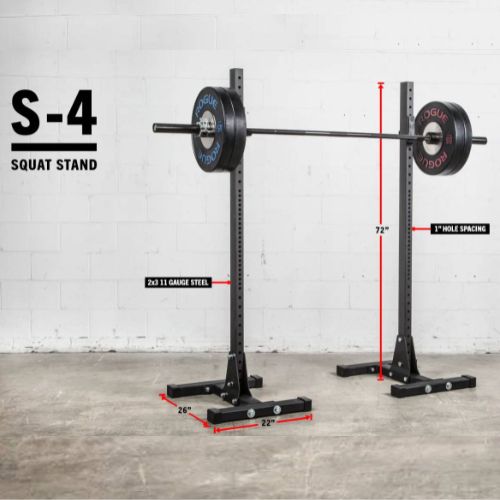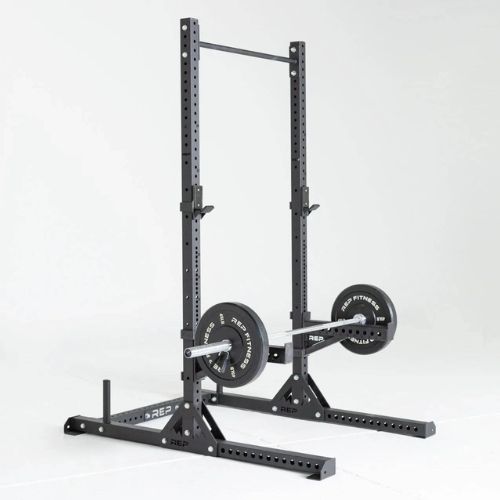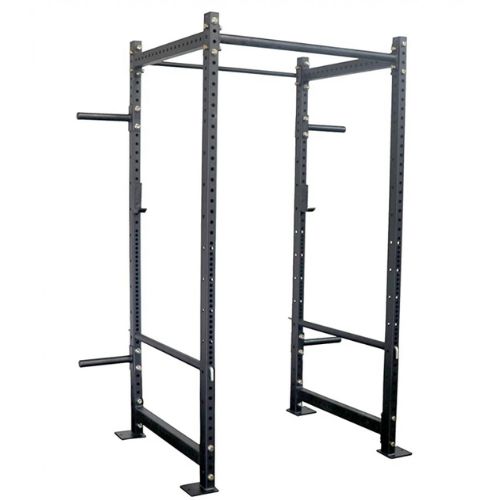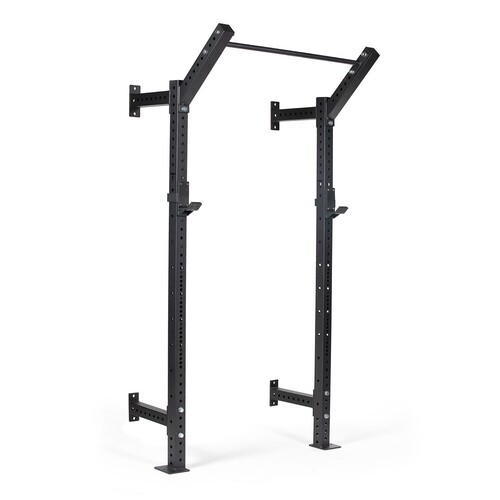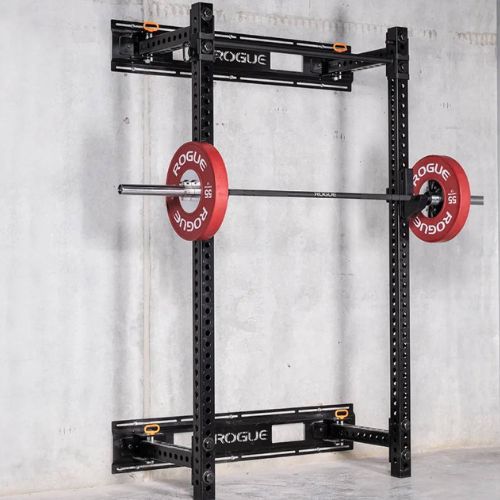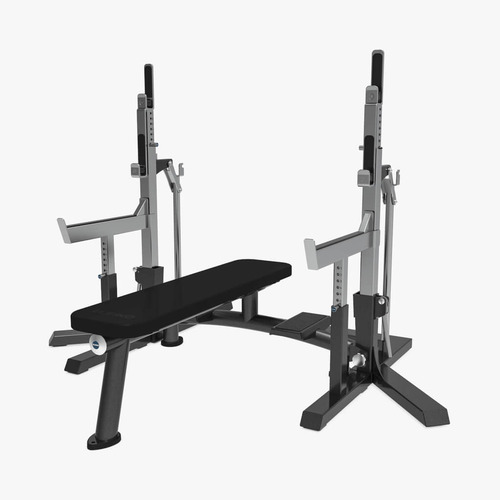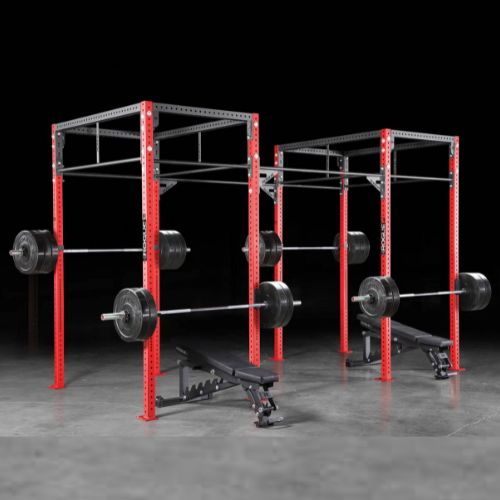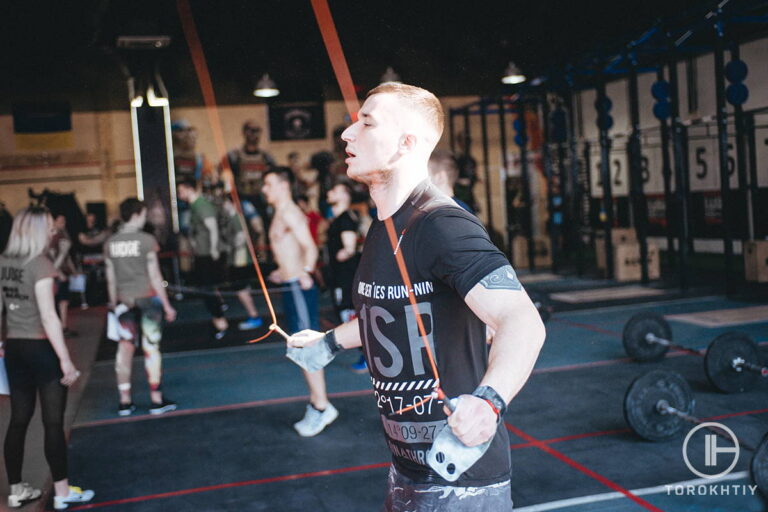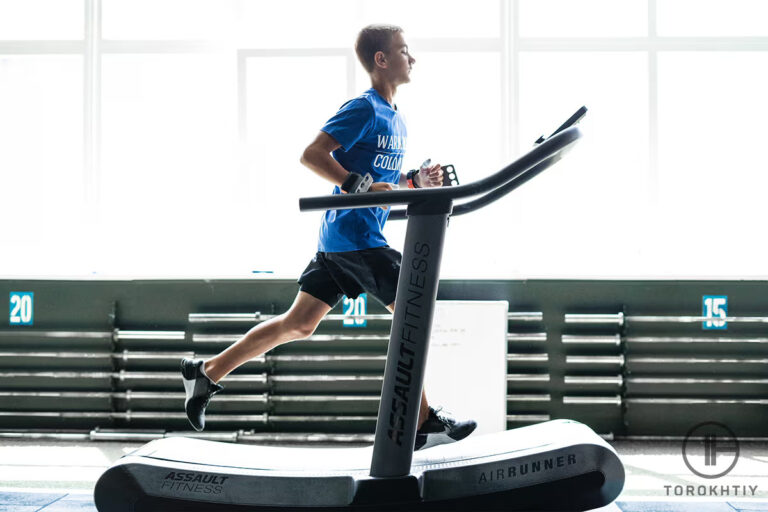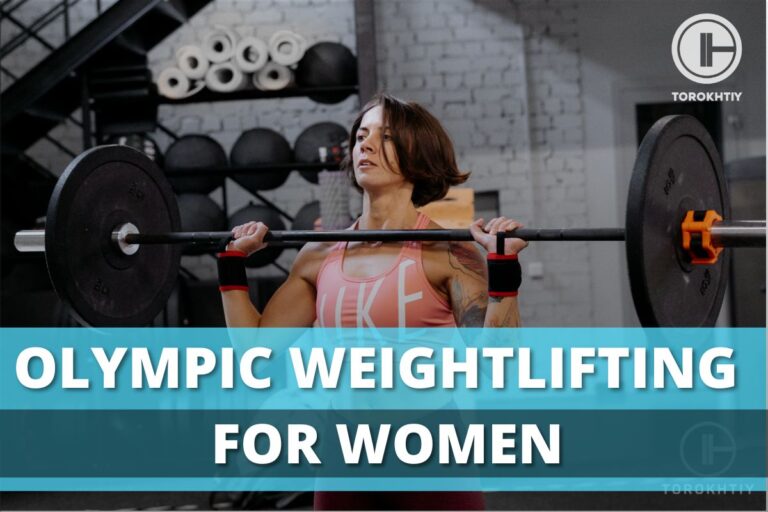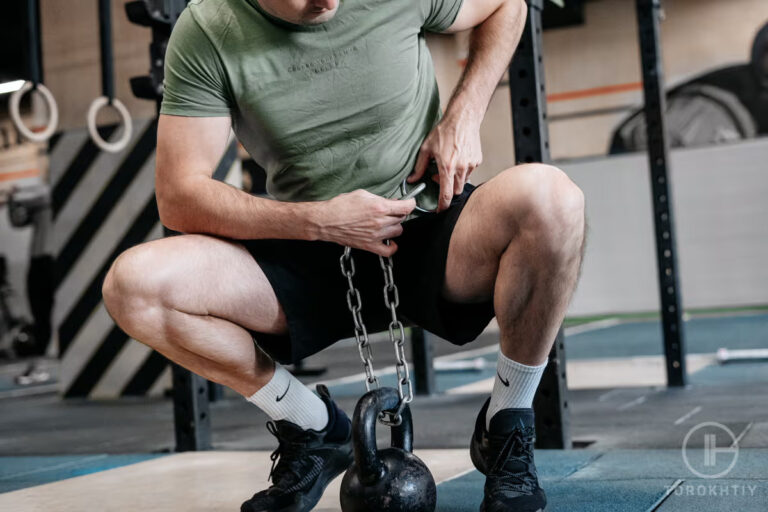10 Different Squat Rack Types: Everything You Need to Know!
There are so many different squat rack types that it can be tough to find the right one for you, so let me help you out with this complete guide.
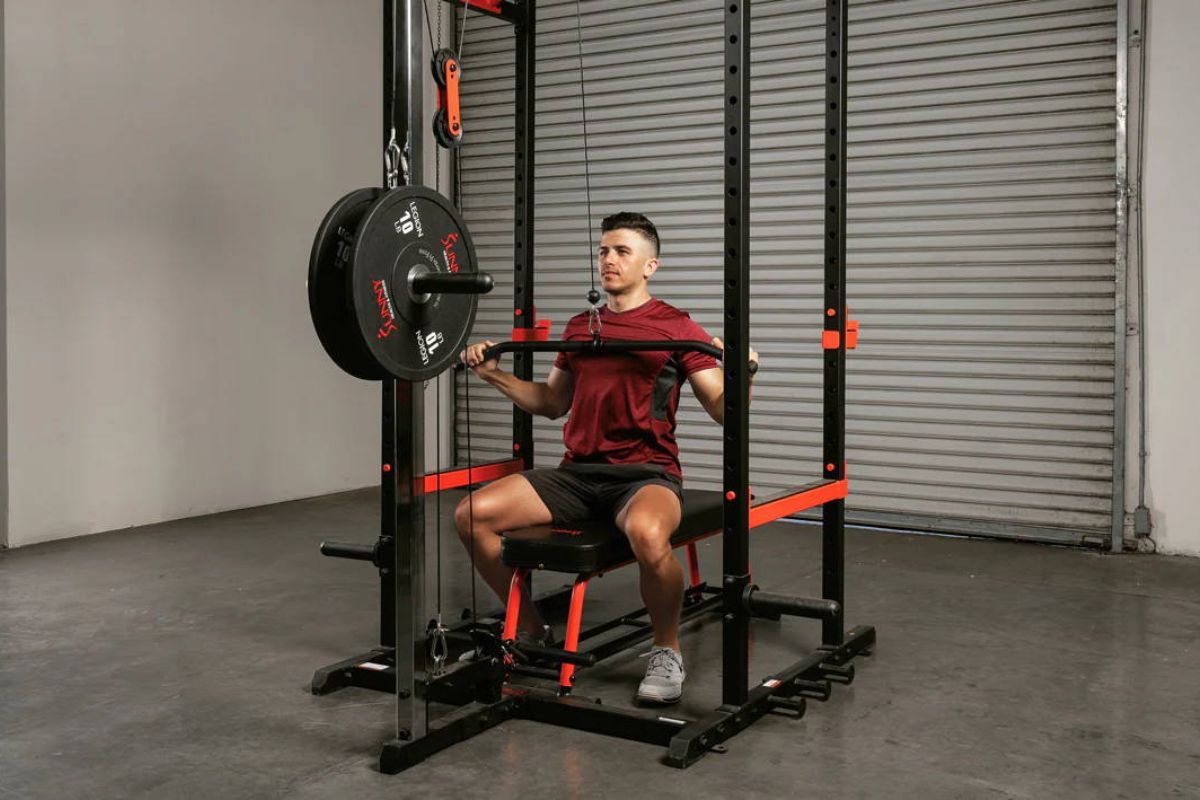
Squat Rack Types
There are 10 different types of squat racks, all with their own pros and cons. Three of the more common types of weightlifting racks are Power racks, Half racks and the classic squat rack. Not all styles of squat rack are the same, and some are much safer than others.
Top 10 Squat Rack Types Reviewed
- Independent Squat Stands
- Linked Squat Stands
- Squat Rack
- Power Rack
- Double Power Rack
- Half Rack
- Wall Mounted Rack
- Foldable Rack
- Combo Rack
- Rig
1. Independent Squat Stands
This is the entry-level squat stand, they are cheap and usually easy to assemble. Essentially they are two upright stands with an adjustable hook on each to hold your barbell.
They are not linked together at all, hence the term independent in the name. What this means for you though is that they are the least safe out of all the options available.
Because the uprights are not connected they can be less stable than other squat racks. Don’t get me wrong, they are not going to fall over at the slightest touch, but it is something to think about.
Our Recommended Squat Stand
The Rouge S-4 2.0 is made from 7 Guage steel and the two H bases add to the rigidity of the rack. It also features rubber feet to protect your flooring and once again improve the stability of the rack.
Like all independent squat stands, they can suffer from stability issues purely because of the fact they are not connected. If this is something you understand and are happy with then these are a great choice.
If you are looking for an independent squat stand setup then this is the best on the market.
Positives:
Could be better:
2. Linked Squat Stands
As the name would suggest these squat stands fix one of the key vulnerabilities with the independent stands above, they are linked together.
This fixes one of the main concerns with the independent squat stands in that they could fall over. Because of the bar linking these stands together that is no longer something you have to worry about, they are a lot more rigid and stable than simple squat stands.
Linked squat stands still have a weakness though in terms of safety and that is because of the open-back design. Because there is no cage or back on the stand there is nothing to catch you or the barbell if you begin to fall backwards and away from the stand.
Our Recommended Linked Squat Stand
This 70” monster lite squat stand really does live up to the name monster. It is a really solid piece of equipment, made from 11-gauge steel tubing for added strength and toughness.
The large footprint of the design adds lots of stability and makes the rack feel a lot sturdier.
Also, the bigger, heavier, footprint of this style of squat rack means you can attach and use spotter arms, this in itself is another huge safety upgrade.
Spotter arms are just two large metal arms that come out of the rack, they are there to catch the barbell if you begin to fall or can’t take the weight any longer.
This rack is popular with gym owners and home gym users as they have a small footprint. This allows for multiples to be used in a commercial gym or allows you to squeeze in more equipment in a home gym scenario.
The more open design on this linked squat stand allows for a wide range of movements and therefore exercises to be done in them. This turns the rack into a more general weightlifting rack rather than just a squat rack
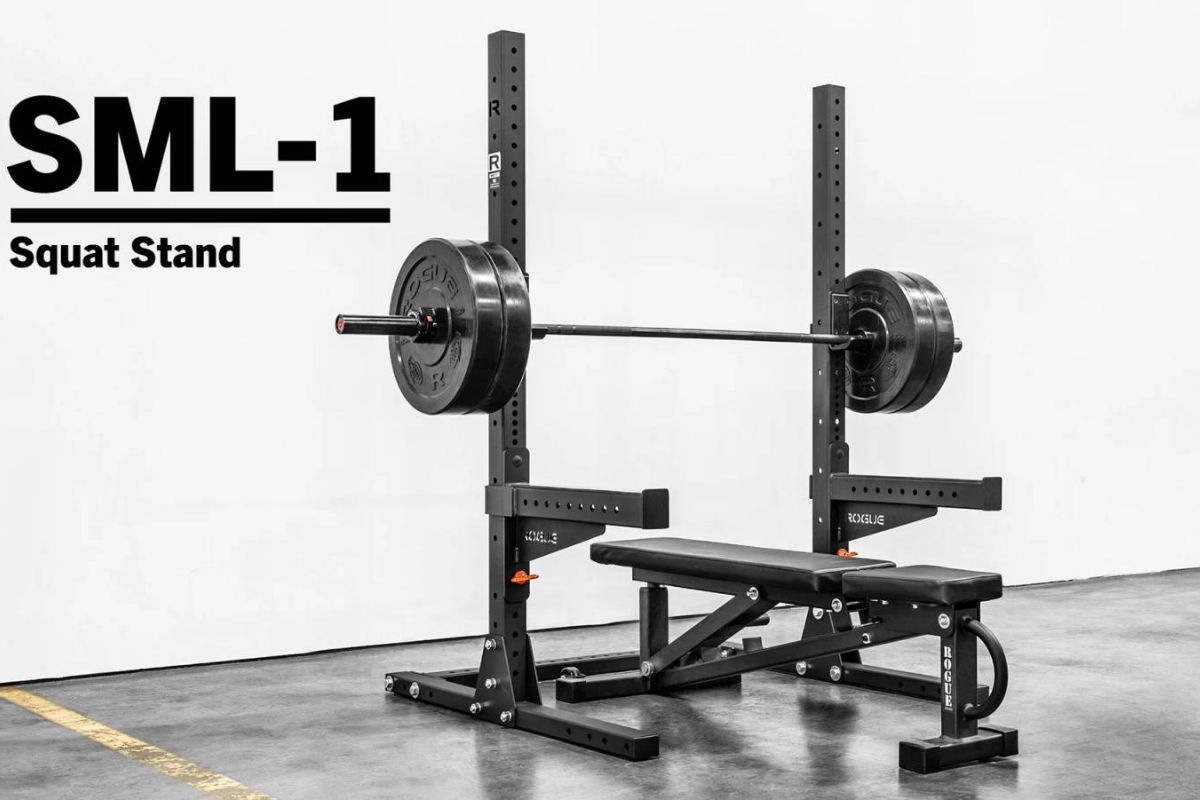
Positives:
Could be better:
3. Squat Rack
The classic squat rack is very similar to a linked squat stand and actually suffers from many of the same downsides. Where it does have an advantage over the linked stands though is that they are joined at the top of the rack as well as the bottom.
This adds to the rigidity and strength of the overall rack, which leads to a much more stable squat rack.
Because a squat rack doesn’t have any top bars you are less restricted with what you can do. The obvious downside to this is that you are not as safe as you are in a power rack.
While a squat rack will often have spotter arms fitted there is nothing to stop you from stepping out of the rack entirely and away from the spotter arms, sometimes without even noticing.
Our Recommended Squat Rack
The SR-4000 squat rack is a great value rack and even comes with J-Cups and a pull-up bar included in the price!
It is available in two different heights, you can choose from 96” and 103” if you need a taller rack. The rack is really heavy-duty and made from 11 gauge steel for added strength.
Spotter arms can be fitted to this squat rack for a much-needed safety net, allowing you to lift heavier weights without worrying about dropping the bar.
The open design of this rack allows for a greater range of movement and also allows for some exercises that are not always possible in full racks.
Take the overhead press, for example, if you are a tally guy or girl and try to press in a fully closed power rack then you may find you hit the top and simply can’t do it. That isn’t a problem in this rack.
Positives:
Could be better:
4. Power Rack
This is the first of the full closed racks on my list. A power rack has four uprights and is also joined at the top and bottom, forming a sort of metal cube.
They are often bolted to the ground to ensure they aren’t going anywhere. This, coupled with the fact they have a closed back makes them much safer than the racks listed above.
Where you pay for this is with your wallet and also the overall footprint of the rack. These racks aren’t cheap and they also take up a lot of room.
Our Recommended Power Rack
The T-3 Series power rack from Titan Fitness is a really affordable way to get your own full rack. The price even includes two J hooks and a pull-up bar! And what’s even better is that you can choose your own custom color powder-coated finish!
This power rack is incredibly popular because it allows one person to work out safely as if they had a spotter with them at all times.
You can’t walk out of the rack because you are fully closed in, you also can’t fall out of the rack with a barbell still on your neck. And if you find the weight on the bar too much you can slowly go down until the barbell catches on the spotter arms and you slide out from underneath.
You can fit spotter arms that run the full depth of the rack, this means that if you fall backwards with a heavy barbell on your shoulders you will catch the frame first and then spotter arms instead of falling all the way out.
When set up correctly it is much harder to have a serious accident on this squat rack than it is on all the others that have come before it.
Positives:
Could be better:
5. Double Power Rack
As you could probably guess from the name this is very similar to a power rack, but with one important difference, they have another smaller section at the back of the rack.
This mini rack area isn’t intended for working out in, it is usually stored for weight plate storage and adding to the strength of the rack.
Our Recommended Double Power Rack
This monster rack is a serious bit of kit and is one of the best squat racks you can buy. If you are serious about your lifting and have the budget then buy this rack, you won’t regret it.
The RM-43 from Rouge is solid as a rock and has every single feature you could ever possibly need from a squat rack.
This is a serious bit of kit and is designed to be as strong and as rigid as possible. It is a huge piece of equipment and is mainly bought by commercial gyms, although if you are lucky enough to have the space and budget for one of these in a home gym then they make a great choice.
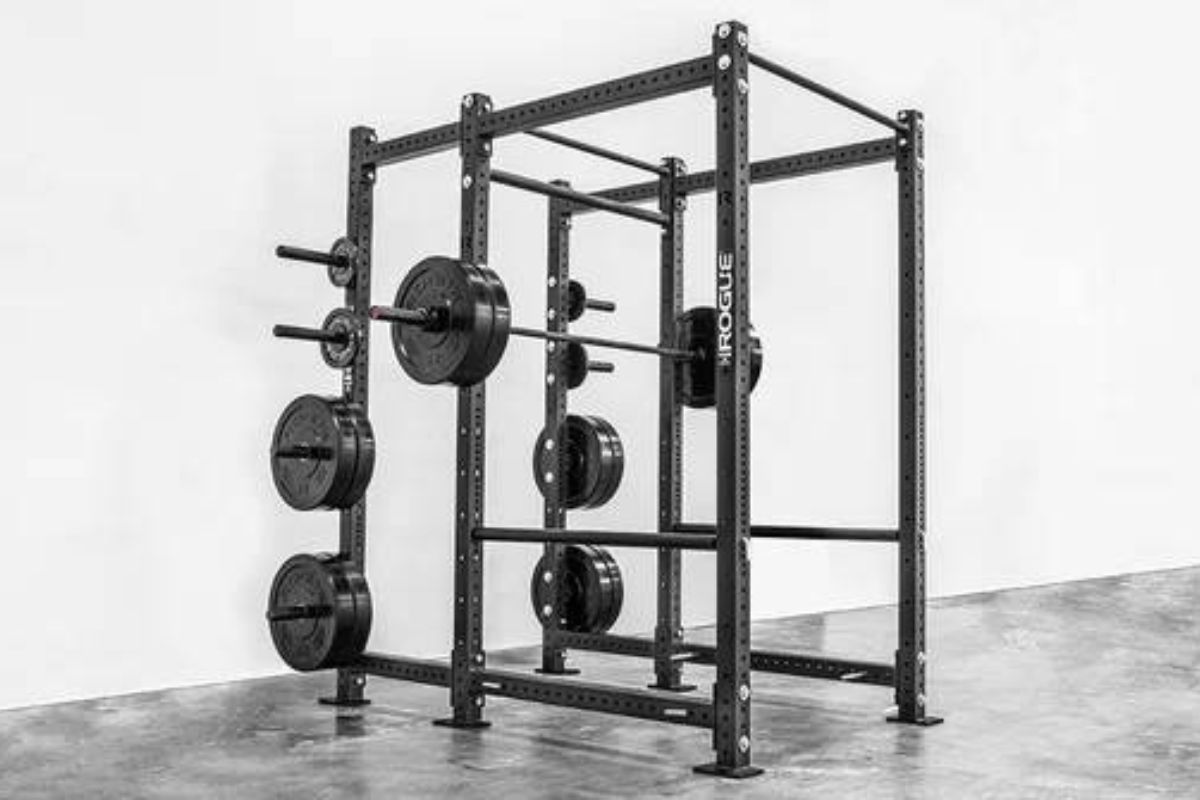
Positives:
Could be better:
6. Half Rack
With the half rack, we are back to squat racks without a back on them. This open design is like a regular squat rack but with another set of uprights at the back of the rack.
These extra uprights add to the strength of the rack and are also used for weight plate storage.
That compactness comes at the same cost as all the other open-backed designs above, safety. As I have said quite a few times now there is nothing to stop you from falling backwards here, which makes it far less safe than a full rack design.
Our Recommended Half Rack
If you are looking for a half rack then this Rogue HR-2 is a great choice. Manufactured in Columbus, Ohio this rack is made from 11-gauge steel and features added cross members for extra strength and rigidity.
While still being a large rack this half rack doesn’t have anywhere near the same footprint as the double power rack or even a full rack.
This is a really versatile design for gyms that don’t have enough room for a full rack.
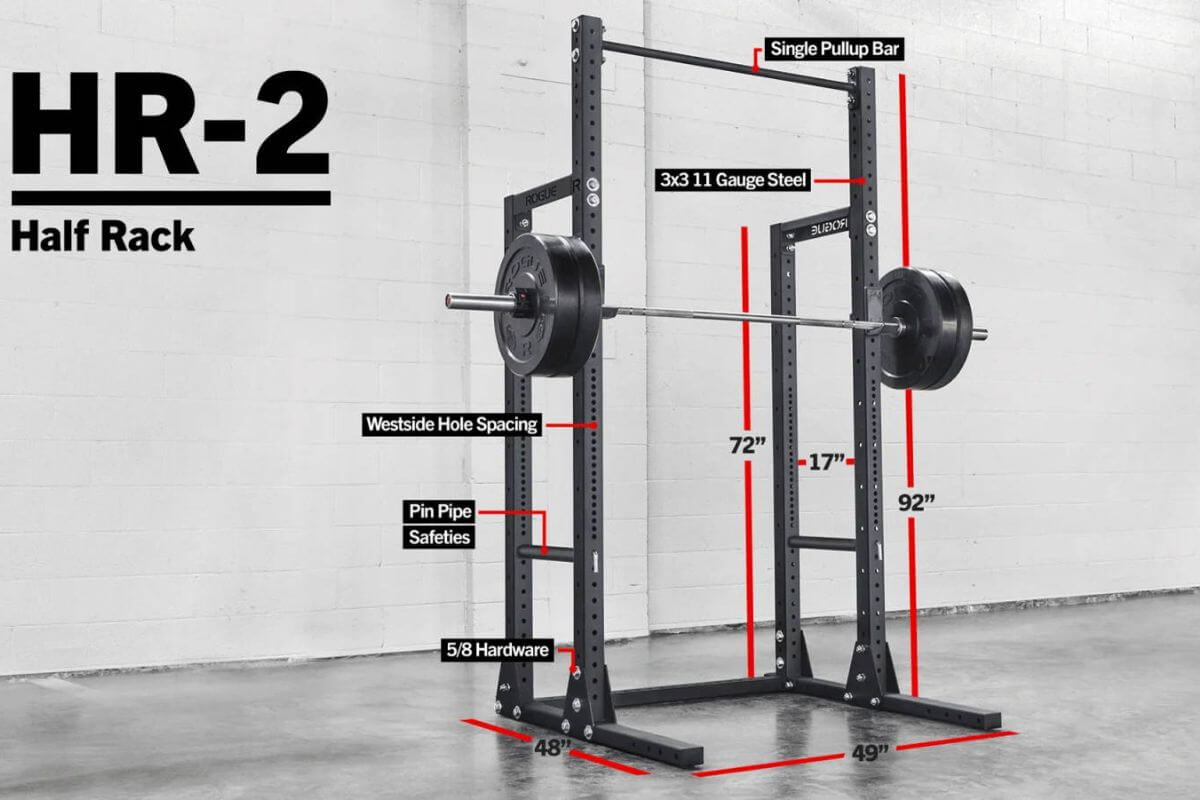
Positives:
Could be better:
7. Wall Mounted Rack
As the name suggests this is a simple rack that you attach to your wall rather than it being free-standing. This saves a lot of space and makes the footprint on these racks tiny.
Usually, these are more of a home gym-style squat rack, but you do see them from time to time in commercial gyms too.
Using spotter arms can also be a bit tricky with this style of rack, as while they can be fitted you don’t want to put too much strain on them.
This is because all of the weight you rest on a spotter arm will be quite a distance from where the rack is bolted to your wall. This will add a lever force putting a lot of strain on the wall.
Our Recommended Wall Mounted Rack
Tight on space? Then this wall-mounted squat rack is for you. The X-3 Series from Titan Fitness is a great rack for those with limited space.
Attach this rack to your wall and away you go. Available in two heights and three different depths you are sure to find the combination that suits you.
The advantage to this rack is the size, it can be a very strong and sturdy squat rack that takes up half the space of a full rack. Also because of the open design, it is suitable for a wide range of exercises.
You can squat, bench, press and much more, all using a single piece of equipment. This is one of the features that make this type of squat rack very appealing to home gym users.
Made from 11-gauge steel with precise laser-cut holes you know you can rely on this squat rack.
Positives:
Could be better:
8. Foldable Rack
This style of squat rack is very similar to the wall-mounted rack, but with one extra feature, it folds into the wall when not in use.
You will only ever see this type of rack in home gyms really, but that is where they work best, when folded away they take up very little room and can simply be folded out when you want to work out.
Our Recommended Foldable Rack
This foldable rack from Rouge takes space saving to the next level. When you are done with your workout simply slide the rack back up against your wall, leaving the rest of the room free to use.
You get all of the same advantages of the wall-mounted rack but with an even smaller footprint.
Available in a range of depths and made from heavy gauge American steel this is a serious squat rack with a tiny footprint. Perfect for home gyms!
Positives:
Could be better:
9. Combo Rack
The combo rack is intended to be a multi-use rack, mainly for squatting and bench pressing in. While you could say that any of the racks above can be used for both squatting and benching in the combo rack is better suited to the life of a multi-use rack.
With a proper multi-rack, you get a competition-level squat rack as well as a competition-level bench press.
A competition combo rack will have some features that you don’t see in other types of racks. These features will be things made for competition lifting.
They also commonly have features to aid weight racking and make it easier for the judges or competition staff who have to regular load and unload the weight.
Our Recommended Combo Rack
If you are looking to do competition lifting then this Eleiko is the combo rack for you. Can be used as a competition squat rack or bench press this is a serious bit of equipment.
This is a true combo rack that excels at being a squat rack and a bench press. If you are a serious lifter then you will feel right at home with this rack.
This rack improves the whole competitive experience, it is better for both the lifter and event organisers with innovative features like a patented tilt mechanism to make changes quicker, easier and safer.
It also has assisted lift mechanisms for getting heavy barbells into position and precise adjustments to make sure everything is in the exact right position.
Positives:
Could be better:
10. Rig
This is the big daddy of all squat racks, a full rig can take up an entire room and is so much more than just a squat rack.
Unless you go to a fitness gym then you have probably never seen a full rig in the flesh, but they are truly something to behold.
This is obviously not for home gyms and is instead designed for massive commercial gyms. You will most often only see a rig in a fitness gym and they are rarely seen in a regular weight lifting gym.
Our Recommended Rig
If you have the room and want the best then this rig from rogue will be right up your street. Perfect for large gyms and fitness clubs alike.
This massive piece of equipment can have a multitude of people working out on it all at the same time without ever getting in each other’s way.
You could have someone squatting, someone benching, another person doing dips and even someone on a punching bag, all within the same piece of equipment.
This rig comes with a dedicated squat rack area where you get all of the benefits of a full rack experience.
Positives:
Could be better:
FAQ
Is A Power Rack Safer Than A Squat Rack?
Yes, a power rack is safer than a squat rack. This is because they are fully closed in, meaning you can’t fall out backwards with the bar. If you begin to fall backwards then the back of the cage will catch the bar, meaning it doesn’t crush you!
What Are The Racks At Gyms Called?
Most gyms will have either a power rack or a squat rack or maybe a combination of both. In larger gyms, you may see double power racks and in fitness gyms, you will often see rigs.
What Is The Difference Between A Squat Rack And A Squat Stand?
A squat rack has two vertical bars and usually a set of hooks with are repositionable and hold your bar. A squat stand is two individual supports that go under the bar and hold it up.
Conclusion
So as we now know there are ten main different squat racks from simple squat stands all the way up to a full rig setup! If you want to learn more about squat racks or have something to share then let me know in the comments below.
Also read:
- Best Dumbbell Rack
- Best Rogue Squat Rack
- Full Rack vs Half Rack
- Squat Stand vs Power Rack vs Squat Rack
- Smith Machine vs Squat Rack
- Squat Rack in Apartment
- Best Squat Rack
- Best Outdoor Squat Rack
- Smith Machine vs Free Weights
References:
- Power rack // Wikipedia: https://en.wikipedia.org/wiki/Power_rack
Why Trust Us?
With over 20 years in Olympic Weightlifting, our team does its best to provide the audience with ultimate support and meet the needs and requirements of advanced athletes and professional lifters, as well as people who strive to open new opportunities and develop their physical capabilities with us.
By trusting the recommendations of our certified experts in coaching, nutrition, dietology, and sports training programming, as well as scientific consultants, and physiotherapists, we provide you with thorough, well-considered, and scientifically proven content. All the information given in the articles concerning workout programming, separate exercises, and athletic performance, in general, is based on verified data. We ensure that you can rely on our professionals’ pieces of advice and recommendations that can be treated as personalized ones which will benefit you and fully meet your needs.
The product testing process is described in more detail here
Author: Ihor Shymechko
Pro Olympic Weightlifter, Coach
Best Results: Snatch – 208 kg,
C&J – 240 kg
Ihor has been a professional weightlifter since 1996, boasting over two decades of competition experience. His notable achievements include clinching the European Championship in 2009 and securing a silver medal in the 105kg division at the Senior World Championships in 2011. Ihor represented his country in the 2008, 2012, and 2016 Summer Olympics. After retiring from competitive weightlifting, he transitioned to coaching, leveraging his vast experience to guide athletes who now compete on both national and international stages.

